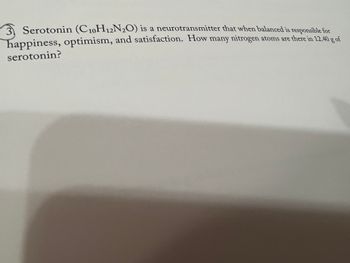
Chemistry
10th Edition
ISBN: 9781305957404
Author: Steven S. Zumdahl, Susan A. Zumdahl, Donald J. DeCoste
Publisher: Cengage Learning
expand_more
expand_more
format_list_bulleted
Concept explainers
Question
Hggggg

Transcribed Image Text:3 Serotonin (C10H12N₂O) is a neurotransmitter that when balanced is responsible for
happiness, optimism, and satisfaction. How many nitrogen atoms are there in 12.40 g of
serotonin?
Expert Solution
This question has been solved!
Explore an expertly crafted, step-by-step solution for a thorough understanding of key concepts.
This is a popular solution
Trending nowThis is a popular solution!
Step by stepSolved in 3 steps

Knowledge Booster
Learn more about
Need a deep-dive on the concept behind this application? Look no further. Learn more about this topic, chemistry and related others by exploring similar questions and additional content below.Similar questions
- Perform the conversions between energy units. 791 kJ= J 3495 kcal= kJ 9.48×10^6 J= kcalarrow_forwardqarrow_forwardORT SHEET Heat of Neutralization EXPERIMENT elemsboomfchg lom 12 A. Heat Capacity of Calorimeter 1. Temp. of calorimeter and water before mixing 2. Temp. of warm water °C 22.0 39,0 30.3 3. Maximum temp. determined from your curve °C 4. Heat lost by warm water (temp decrease x °C 50.0 g x 4.184 J/K-g) = 02), 5. Heat gained by cooler water (temp. increase x 50.0 g x 4.184 J/K-g) = 30,3 22.0)x 13626J s0.0gmpi S0.0gy 6. Heat gained by the calorimeter [(4) – (5)] = 7. Heat capacity of calorimeter: heat gained by the calorimeter temperature increase J/K 3. Heat of Neutralization of HCl-NaOH 22.2 22.2. °C . Temp. of calorimeter and NaOH Temp. of HCI AT determined from your curve after adding HC1 °C to the NaOH Heat gained by solution (temperature increase x ON 100 g x 4.184 J/K-g) = 9977.8J %3D Heat gained by calorimeter (temperature increase x heat capacity of calorimeter) = J %3D Total joules released by reaction [(3) + (4)] = Tight O 2018 Pearson Education, Inc.arrow_forward
- 5. 'Н H H US LDA H₂O LDA H₂Oarrow_forwardUsing the equations N₂ (g) + 3 H₂ (g) → 2 NH₂ (9) AH° = -91.8 kJ/mol C(s) + 2 H₂(g) →→ CH₂ (g) AH° = -74.9 kJ/mol H₂(g) + 2 C(s) + N₂ (g) → 2 HCN (g) AH° = 270.3 kJ/mol - Determine the enthalpy (in kJ/mol) for the reaction CH₂(g) + NH₂(g) → HCN (g) + 3 H₂ (g).arrow_forward*54. A compound called di-t-butyl peroxide [abbreviation DTBP, formula (CH3);COOC(CH3)3] decomposes to give acetone [(CH3),CO] and ethane (C,H,): (CH3); COOC(CH3)3 (g) → 2 (CH;)2CO(g) + C2H6 (g)arrow_forward
- if 1 cal rises the temp of 1ml of water by 1 degree celcius, how many calories are needed to raise the tempeture of 50ml of water by 1 degree celcius ?arrow_forward1) Use Hess's Law to determine AH for the following target reaction. 3 CO₂(g) + 4 H₂O(g) b) C3Hg(g) + 5 O₂(g) C(s) + O₂(g) -CO₂(g) 2 H₂(g) + O₂(g) 3 C(s) + 4 H₂(g) →→→ 2 H₂O(g) C3H8(g) AH = AH = ΔΗ ΔΗ = ??? -2043 kJ -393.5 kJ -483.6 kJarrow_forwardThe Nutrition Facts label for one slice of wheat bread gives Nutrition Facts the percent daily value of various nutrients based on a 2,000-kcal diet. Based on the percent daily values for the nutrients, calculate how many grams of each nutrient are Serving Size: 1 slice (25g) Amount Per Serving Calories 76 Calories from Fat 9 suggested daily for a 2,000-kcal diet. % Daily Value Total Fat 1.02 g 296 Saturated Fat 0.23 g 196 Trans Fat Cholesterol 0 mg Dietary fiber: Sodium 145.75 mg 696 Potassium 81.5 mg 296 Total Carbohydrate 12.79 g 496 Dietary Fiber 2.3 g g96 Sugars 1.44 g Total fat: Sugar Alcohols Protein 4.07 g Vitamin A 1 IU 0% Vitamin C 0 mg 0% Calcium 32.5 mg 3% Saturated fat: Iron 0.74 mg 4% Sodium: obout us careers privecy policy terma of uae contact us help Lr O 79°Farrow_forward
arrow_back_ios
SEE MORE QUESTIONS
arrow_forward_ios
Recommended textbooks for you
 ChemistryChemistryISBN:9781305957404Author:Steven S. Zumdahl, Susan A. Zumdahl, Donald J. DeCostePublisher:Cengage Learning
ChemistryChemistryISBN:9781305957404Author:Steven S. Zumdahl, Susan A. Zumdahl, Donald J. DeCostePublisher:Cengage Learning ChemistryChemistryISBN:9781259911156Author:Raymond Chang Dr., Jason Overby ProfessorPublisher:McGraw-Hill Education
ChemistryChemistryISBN:9781259911156Author:Raymond Chang Dr., Jason Overby ProfessorPublisher:McGraw-Hill Education Principles of Instrumental AnalysisChemistryISBN:9781305577213Author:Douglas A. Skoog, F. James Holler, Stanley R. CrouchPublisher:Cengage Learning
Principles of Instrumental AnalysisChemistryISBN:9781305577213Author:Douglas A. Skoog, F. James Holler, Stanley R. CrouchPublisher:Cengage Learning Organic ChemistryChemistryISBN:9780078021558Author:Janice Gorzynski Smith Dr.Publisher:McGraw-Hill Education
Organic ChemistryChemistryISBN:9780078021558Author:Janice Gorzynski Smith Dr.Publisher:McGraw-Hill Education Chemistry: Principles and ReactionsChemistryISBN:9781305079373Author:William L. Masterton, Cecile N. HurleyPublisher:Cengage Learning
Chemistry: Principles and ReactionsChemistryISBN:9781305079373Author:William L. Masterton, Cecile N. HurleyPublisher:Cengage Learning Elementary Principles of Chemical Processes, Bind...ChemistryISBN:9781118431221Author:Richard M. Felder, Ronald W. Rousseau, Lisa G. BullardPublisher:WILEY
Elementary Principles of Chemical Processes, Bind...ChemistryISBN:9781118431221Author:Richard M. Felder, Ronald W. Rousseau, Lisa G. BullardPublisher:WILEY

Chemistry
Chemistry
ISBN:9781305957404
Author:Steven S. Zumdahl, Susan A. Zumdahl, Donald J. DeCoste
Publisher:Cengage Learning

Chemistry
Chemistry
ISBN:9781259911156
Author:Raymond Chang Dr., Jason Overby Professor
Publisher:McGraw-Hill Education

Principles of Instrumental Analysis
Chemistry
ISBN:9781305577213
Author:Douglas A. Skoog, F. James Holler, Stanley R. Crouch
Publisher:Cengage Learning

Organic Chemistry
Chemistry
ISBN:9780078021558
Author:Janice Gorzynski Smith Dr.
Publisher:McGraw-Hill Education

Chemistry: Principles and Reactions
Chemistry
ISBN:9781305079373
Author:William L. Masterton, Cecile N. Hurley
Publisher:Cengage Learning

Elementary Principles of Chemical Processes, Bind...
Chemistry
ISBN:9781118431221
Author:Richard M. Felder, Ronald W. Rousseau, Lisa G. Bullard
Publisher:WILEY